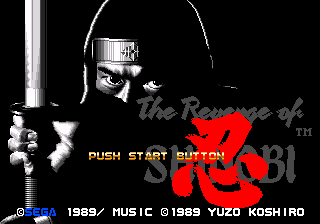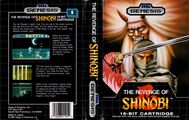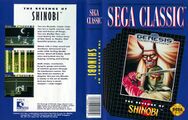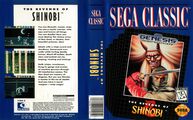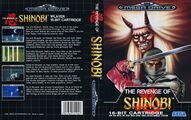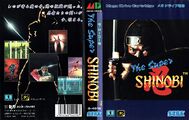The Revenge of Shinobi
From Sega Retro
| This article needs cleanup. This article needs to be edited to conform to a higher standard of article quality. After the article has been cleaned up, you may remove this message. For help, see the How to Edit a Page article. |
| The Revenge of Shinobi / The Super Shinobi | |||||
|---|---|---|---|---|---|
| System(s): Sega Mega Drive, Sega Mega-Tech, Virtual Console, Steam | |||||
| Publisher: Sega | |||||
| Developer: Sega | |||||
| Genre: Action | |||||
| |||||
|
CERO
Missing Parameter! |
The Revenge of Shinobi, released as The Super Shinobi (ザ・スーパー忍) in Japan, is a 1989 Sega Mega Drive game, developed and published by Sega. Alongside Shadow Dancer, it is the first sequel to Shinobi, and the first game in the Shinobi series released for the Mega Drive. It should also not be confused with the 2002 game with the same name. It was later released on the Mega Drive based arcade platform the Mega-Tech.
The game was also released in several compilations: Mega Games 2 and 6-Pak for the Mega Drive, Sega Classics Arcade Collection for the Sega Mega-CD, Sega Smash Pack for PCs, and Sega Smash Pack for the Sega Dreamcast. It was re-released for the Nintendo Wii's Virtual Console in 2009.
Contents
Story
Taking place three years after Shinobi, the criminal organization Zeed from the original game has since reformed and renamed themselves Neo Zeed (literally New Zeed). Neo Zeed decide to have their revenge on the first game's protagonist Joe Musashi and his fellow members of the Oboro Ninja Clan, by killing Joe's master and kidnapping his fiance Naoko. Joe, having reached his Clan too late, manages to learn of Neo Zeed's plot from his dying master. Joe decides to travel the world to gain his revenge on Neo Zeed, and try to save his fiance before it's too late.
Gameplay
Basics
The Revenge of Shinobi is a traditional side-scrolling platform game. The player controls Joe Musashi, who must traverse 8 districts (Rounds; see below) before his final confrontation with the head of Neo Zeed. Each district consists of 3 scenes, the last of which is a battle against a unique boss character.
The D-pad moves Joe around, while ![]() ,
, ![]() and
and ![]() are used to perform a ninjitsu technique, attack (with sword or shuriken knives, which must be collected) and jump respectively. A key move in The Revenge of Shinobi is the somersault, performed by jumping and pressing jump again at the height of a jump. The somersault maximizes Musashi's jumping height and enables him to throw 8 shuriken at once in mid-air. Additionally, some stages consist of multiple layers (e.g. indoor/outdoor, on or next to the road); switching between these is also accomplished using the somersault move.
are used to perform a ninjitsu technique, attack (with sword or shuriken knives, which must be collected) and jump respectively. A key move in The Revenge of Shinobi is the somersault, performed by jumping and pressing jump again at the height of a jump. The somersault maximizes Musashi's jumping height and enables him to throw 8 shuriken at once in mid-air. Additionally, some stages consist of multiple layers (e.g. indoor/outdoor, on or next to the road); switching between these is also accomplished using the somersault move.
Ninjutsu techniques
Besides his regular assortment of moves and attacks, Musashi has the ability to perform four special ninjutsu techniques. Only one can be used in each level, unless a Ninjitsu item was picked up, or the ninjutsu of Mijin was used to reset your life total. The four techniques employed by Joe are as follows:
- Ninjutsu of Ikazuchi (the art of thunder): Envelopes Musashi with a shield of lightning energy that sustains damage for four consecutive hits.
- Ninjutsu of Karyu (the art of fire): Summons four dragon-shaped columns of flame that move across the screen and damage all enemies in their path.
- Ninjutsu of Fushin (the art of floating): Improves Musashi's agility by heightening his jumping capability.
- Ninjutsu of Mijin (the art of pulverizing): The most powerful Ninjutsu technique in the game. Musashi explodes, damaging all enemies on screen at the cost of one life. Minjin will, like Karyu, destroy all weaker enemies on screen, but with this Ninjitsu, Musashi's power against boss enemies is much greater. This is an interesting and strategic Ninjitsu, as though Joe loses a life in performing it, doing so causes his health to be fully restored and he is granted an extra Ninjitsu attack. It is possible to use Mijin on Joe's last life, but this requires a Continue to be used to resume his quest.
Power-ups
A variety of crates can be found in each level, some hidden in the scenery. These contain simple power-ups such as extra shuriken or health packs, as well as special items that award extra lives or Ninjutsu uses. Howeverm some crates contain time bombs, which detonate when their fuse runs out or if Musashi comes too close (though he can walk out of the blast radius if the player is quick enough).
Options
The game is divided into four difficulties: Easy, Normal, Hard, and Hardest. As difficulty increases, more enemies appear per stage, Musashi takes twice as much damage on Hardest and the amount of starting lives decreases from 10 to 1. From the options menu, the player can also choose the amount of starting shuriken from 0 to 90 (though a code does exist that allows infinite shuriken).
Rounds
- Ibaraki Province, Japan: This bamboo forest is where the game begins. Through these ancient ruins, Musashi must make his way to The House of Confusion. At the end of this district, he is confronted by the mighty samurai Blue Lobster.
- Tokyo: Musashi begins this stage near a rocky canyon. Winged ninja swoop down from the sky to attack him. Past the waterfalls, Joe stalks the darkened roof tops of Tokyo, and eventually enters a blinding disco where he must battle with the Shadow Dancer.
- The Military Base: This military complex of Neo Zeed's is heavily guarded by armed soldiers. Joe must contend against light infantry as well as enemies armed with flame throwers and attack dogs. The second scene takes him on board an air carrier. If he touches one of the air locks, he dies. The aircraft is controlled by a powerful supercomputer that houses a human brain, which Joe must defeat in order to progress.
- Detroit: Detroit is one big junkyard, with countless cars being moved by conveyor belts and into a melting furnace. A tough Terminator-like android guards the site.
- Area Code 818: This stage takes Musashi past skyscrapers and freeways. The final battle is fought on top of an armoured vehicle carrying a gigantic ballistic missile.
- Chinatown: After a showdown with the kung-fu gangs of Chinatown, Musashi hops on board a speeding train. Eventually he finds himself in the clutches of a shapeshifter who attacks in the form of Spider-Man and Batman. A revised version (1.01; see below) of the game replaced Batman with Devilman.
- New York: Ninja and machine gunners guard the breakwater of New York's dockside. Leaping from boat to boat, Joe infiltrates Neo Zeed's container ship and comes face to face with Godzilla.
- Neo Zeed Marine Stronghold: Here Musashi will face his final enemy, the leader of Zeed himself. His fiancee Naoko is trapped somewhere beneath the maze-like cellars of this stronghold, and Joe must terminate Zeed quickly before Naoko is killed by the latter's trap.
Versions
Retail
Because of copyright issues regarding certain boss characters (many of which were based on cultural icons) there were at least four versions of the game released in Europe and North America, with the later two also appearing in Europe. Another revision was eventually released for the Nintendo Wii's Virtual Console.
| Version | ROM CRC32 | GoodGen Filename | no-intro Filename | Details |
|---|---|---|---|---|
| 1.00 (1989) | 5c7e5ea6 | Revenge of Shinobi, The (W) (REV00) [!].gen | Super Shinobi, The (Japan).md | The Super Shinobi. This is the original 'final' version, only released in Japan and the only version released in Japan. Bosses clearly resembling Godzilla, Spider-Man, the Terminator and Batman are present. Both Spider-Man (albeit red and black, not red and blue) and Batman are actually impersonations by the boss of Chinatown, who upon defeat reverts to a small bat-like creature and flies away. Furthermore, enemies with flamethrowers resemble the movie character John Rambo. |
| 1.01 (1989) | 05f27994 | Revenge of Shinobi, The (W) (REV01) [!].gen | Revenge of Shinobi, The (USA, Europe).md | The Revenge of Shinobi. First international release. Batman is replaced by the anime character Devilman. Godzilla and Spider-Man remain unmodified, the latter still morphing into the bat-like creature when defeated. Enemy soldiers with flamethrowers are also changed to bald men with headbands, away from their original likeness to John Rambo. |
| 1.02 (1990) | fe91ab7e | Revenge of Shinobi, The (W) (REV02) [!].gen | Revenge of Shinobi, The (USA, Europe) (Rev A).md | The Revenge of Shinobi. Second international release. The fake Spider-Man is recoloured into the licensed character from Marvel Comics, and acknowledged by a copyright notice (Sega already had the license to the character for another game they were developing at the time, Spider-Man vs. The Kingpin). Since he is now the real Spider-Man, he doesn't morph into a bat-like shape; instead he actually leaves the battle when enough damage is inflicted, with Devilman entering to replace him. Godzilla is unaltered. |
| 1.03 (1990) | 4d35ebe4 | Revenge of Shinobi, The (W) (REV03) [!].gen | Revenge of Shinobi, The (USA, Europe) (Rev B).md | The Revenge of Shinobi. Third international release. Godzilla is replaced by a skeletal dinosaur. Everything else remains intact from the previous revision, including the licensed use of Spider-Man. This version was used in the 6-Pak cartridge. |
| 1.04 (2009) | (Unknown) | (Doesn't appear to be in GoodGen) | (In the custom DAT for Virtual Console releases) | Since the licensed use of Spider-Man was for a limited period of time, the game was subsequently prevented from being re-released in recent years on compilations and digital download services. The 2009 release for the Nintendo Wii Virtual Console features a new specific software revision that omits the Marvel copyright notice and replaces Spider-Man with a pink palette swap of the character, which still behaves the same as the licensed Spider-Man [1]. The picture of Sonny Chiba used on the title screen was also altered slightly to resemble a more generic ninja, presumably as the license to use his likeness also expired. ([2]) |
Prototypes
Prototype versions also exist, one of which was (presumably mistakenly) released on the compilation Sega Smash Pack. This version features some cheats enabled by default, missing bosses and music, and other differences [3].
Soundtrack
The Revenge of Shinobi's soundtrack was composed by Yuzo Koshiro, who composed the music for other games including the Streets of Rage series.
A suite of music from The Revenge of Shinobi was performed live by an orchestra at the Fourth Symphonic Game Music Concert in 2006 at the Gewandhaus zu Leipzig, Germany. The arrangement was done by Koshiro himself. Music from the game was also performed at two concerts of PLAY! A Video Game Symphony in Stockholm, Sweden in 2007, and during the encore as the most voted song when PLAY! was performed in Singapore in June 2007.
Trivia
The introductory cutscene and subsequent title screen feature the famous martial arts actor Sonny Chiba dressed as Hattori Hanzō from the popular TV series Kage No Gundan.
Production Credits
Physical Scans
Mega Drive version
| 86 | |
|---|---|
| Based on 41 reviews | |
| Mega Drive, US (Sega Classic) |
|---|
| Mega Drive, US (Sega Classic; 1995 re-release) |
|---|
Mega-Tech version
External links
- Sega of Japan Virtual Console page (Japanese)
- The Revenge of Shinobi on Steam
- The Revenge of Shinobi at Mobygames
- Hardcore Gaming 101: Shinobi examines the entire Shinobi series
| Games in the Shinobi series | |
|---|---|
| Shinobi (1987) | Shadow Dancer (1989) | |
| Shinobi (1988) | The Cyber Shinobi (1990) | Shadow Dancer (1991) | |
| Shinobi (1989) | |
| The Revenge of Shinobi (1989) | Shadow Dancer: The Secret of Shinobi (1990) | Shinobi III: Return of the Ninja Master (1993) | |
| The GG Shinobi (1991) | The GG Shinobi II: The Silent Fury (1992) | |
| Shinobi Legions (1995) | |
| The Revenge of Shinobi (2002) | |
| Shinobi (2002) | Nightshade (2003) | |
| Shinobi 3D (2011) | 3D Shinobi III (2013) | |
| Sega Ages Shinobi (2019) | |
| Shinobi related media | |
| The Super Shinobi & Works (1989) | Shinobi Original Soundtrack (2002) | Legend of Joe Musashi: Shinobi Music Collection (2009) | Shinobi 3D Original Soundtrack (2012) | Kunoichi Original Soundtrack (2014) | Shinobi III: Return of the Ninja Master (2015) | The Revenge of Shinobi (2016) | Shadow Dancer: The Secret of Shinobi (2022) | |
| Shinobi: The Fear Pavilion (1994) | Shin Shinobi Den Hisshou Kouryaku Hou (1995) | Prima's Official Strategy Guide: Shinobi (2002) | Shinobi: The Rise of Hotsuma (2002) | Shinobi: The Complete Guide (2002) | Shinobi the Wide Ilustration Archive (2003) | Kunoichi Koushiki Guide Book (2003) | Kunoichi Perfect Guide (2004) | |
- ↑ 1700 igr dlya Sega, "" (RU; 2001-xx-xx), page 187
- ↑ 1700 igr dlya Sega, "" (RU; 2001-xx-xx), page 207
- ↑ Aktueller Software Markt, "März 1990" (DE; 1990-0x-xx), page 80
- ↑ Beep! MegaDrive, "February 1990" (JP; 1990-01-08), page 68
- ↑ Computer Entertainer, "January 1990" (US; 1990-01-20), page 18
- ↑ Complete Guide to Consoles, "Volume Two" (UK; 1990-04-xx), page 98
- ↑ Complete Guide to Consoles, "Volume IV" (UK; 1990-11-xx), page 36
- ↑ The Complete Guide to Sega, "" (UK; 1991-05-xx), page 50
- ↑ Console XS, "June/July 1992" (UK; 1992-04-23), page 133
- ↑ Cool Gamer, "9" (RU; 2002-10-13), page 186
- ↑ Computer & Video Games, "February 1990" (UK; 1990-01-16), page 92
- ↑ Electronic Gaming Monthly, "March 1990" (US; 1990-xx-xx), page 20
- ↑ Entsiklopediya luchshikh igr Sega. Vypusk 10, "" (RU; 2003-10-08), page 133
- ↑ Mean Machines: The Essential Sega Guide, "" (UK; 1993-11-18), page 83
- ↑ Famitsu, "1990-01-05,19" (JP; 19xx-xx-xx), page 17
- ↑ The Games Machine, "March 1990" (UK; 1990-02-08), page 36
- ↑ Joystick, "Juin 1990" (FR; 1990-05-xx), page 76
- ↑ Sega Mega Drive Advanced Gaming, "November 1992" (UK; 1992-xx-xx), page 78
- ↑ Sega Mega Drive Advanced Gaming, "January 1993" (UK; 199x-xx-xx), page 94
- ↑ Mega Drive Fan, "March 1990" (JP; 1990-02-08), page 63
- ↑ Mega, "June 1993" (UK; 1993-05-20), page 21
- ↑ Mega Action, "June 1993" (UK; 1993-05-20), page 65
- ↑ Mega Fun, "09/93" (DE; 1993-08-18), page 73
- ↑ MegaTech, "Xmas 1991" (UK; 1991-12-06), page 80
- ↑ MegaTech, "May 1993" (UK; 1993-04-23), page 94
- ↑ Mean Machines, "October 1990" (UK; 1990-09-xx), page 16
- ↑ Mean Machines Sega, "October 1992" (UK; 1992-09-xx), page 140
- ↑ Megazone, "June/July 1991" (AU; 1991-0x-xx), page 23
- ↑ Player One, "Octobre 1990" (FR; 1990-xx-xx), page 36
- ↑ Power Play, "3/90" (DE; 1990-02-19), page 97
- ↑ Raze, "January 1991" (UK; 1990-11-29), page 58
- ↑ Sega Power, "January 1991" (UK; 1990-12-06), page 18
- ↑ Sega Power, "October 1991" (UK; 1991-09-05), page 54
- ↑ Sega Pro, "March 1992" (UK; 1992-02-20), page 51
- ↑ Sega Pro, "April 1993" (UK; 1993-03-11), page 67
- ↑ Sega Saturn Magazine, "September 1995" (JP; 1995-08-08), page 85
- ↑ Tilt, "Septembre 1990" (FR; 1990-0x-xx), page 63
- ↑ Tricks 16 bit, "Tricks Sega Gold 800 igr" (RU; 1998-03-20), page 141
- ↑ Tricks 16 bit, "Tricks Sega Gold 800 igr" (RU; 1998-03-20), page 254
- ↑ User, "Noémvrios 1990" (GR; 1990-1x-xx), page 63
- ↑ Zero, "March 1990" (UK; 1990-0x-xx), page 51
- Cleanup
- No players field
- Old content rating field
- Use romtable template
- All games
- Old-style rating (asm)
- Rating without source
- Old-style rating (cgtc)
- Rating without PDF source
- Old-style rating (cvg)
- Old-style rating (gamesmachineuk)
- Old-style rating (joystick)
- Old-style rating (mdag)
- Old-style rating (mega)
- Old-style rating (megaaction)
- Old-style rating (megafun)
- Old-style rating (megatech)
- Old-style rating (mm)
- Old-style rating (playerone)
- Old-style rating (pp)
- Old-style rating (raze)
- Old-style rating (segapower)
- Old-style rating (segapro)
- Old-style rating (tilt)
- Old-style rating (zero)
- Update ratings template
- 21 old ratings
- Shinobi (franchise)
- Mega-Tech games
- Sega Channel games
